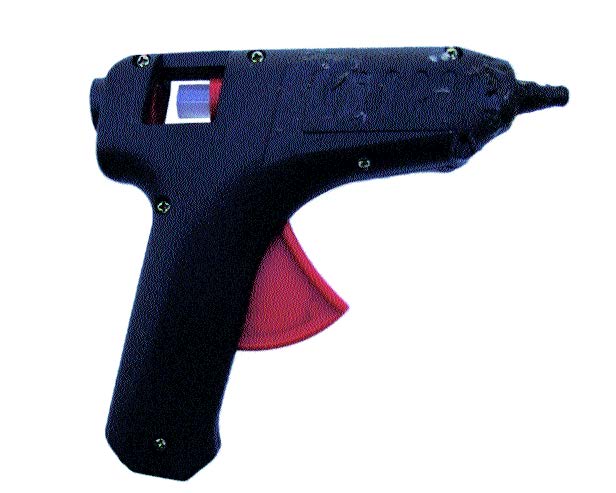FEATURES:
- Built-in Workstand
- Viewing Gauge
- Trigger Feed
If for whatever reason you desire to attach two objects together, generally those don’t naturally come that way, look into a hot glue gun. A bottle of Elmer’s or a cylindrical tube of Krazy Glue works best for like/like adhesion (construction paper collages) or when you need the items being stuck to lie flush against one another (cracks in wainscoting). But if your purpose is costuming, stagecrafts, or work in three dimensions, you’ll need something with a quicker dry.
A recent art project brought me to a midsized model Ace Hardware Heavy-Duty Glue Gun ($11.99). In appearance it’s a hybrid of a bit drill and a water pistol with a heavy plastic red trigger to indicate proper gripping. Guns vary in price based on how long you want to work without reheating, how much glue you need per squeeze, and the task at hand. Mine comes with a hollowed-out viewing gauge so you can tell when it’s time to reload.
A hot glue gun is preheated by plugging it into an outlet and letting it rest on its workstand so the hot barrel doesn’t scald your countertop. You then load a dowel-shaped glue stick into a round opening on the butt of the tool and pull the trigger. A tab feeds the stick into a heated chamber where the glue melts and is released through an aluminum nozzle, in fat globs if you squeeze hard and quick, or in thin streams with evenly applied gentle pressure. When you can’t see the stick in the viewing gauge, you load another in directly behind the first.
My project involved gluing beads to a tree branch, an idea I’d stolen from a museum exhibit on American folk art. After waiting five minutes for the gun to heat, I situated myself near the outlet to work. The neighborhood hardware store had told me that an unplugged gun will cool completely in about that much time, leaving you with a gluing tool that does everything but emit glue.
My first applications were rushed and sloppy as I squeezed too hard and ended up with an almond-size dollop on my branch. It held the beads just fine, drying in a few seconds, but hardly in the smooth, invisible manner I had imagined. The beads looked like they wanted to leap off the branch and this waxy mess was holding them back.
Another try confirmed that I needed to give the trigger about three squeezes to load the glue before anything came out. More than that resulted in occupational waste, like the first staple lost from loading a new row into an empty stapler. But after few tries, my gun released glue in neat lines, holding beads as soon as I set them down. And unlike an Elmer’s bottle, I didn’t have to clean hardened glue from the tip after I finished. Reheating melted it away.
Higher-end industrial-use guns can run in the hundreds of dollars and are often designed to run cordless for long periods without reheating and apply a range of adhesives including liquefied metal. Other models are air-pressurized to “shoot” glue rather than simply dribble it out. Regardless of the job, a steady hand and a precise eye are crucial. Little wonder, then, that the crafting version of the tool is nicknamed “The Martha Stewart Six-Shooter.”
I asked Kristin, a clerk at my neighborhood hardware store, why anyone would use traditional glue in bottles and tubes when you could apply it precisely how you wanted with a glue gun. “Convenience and safety,” she said. “Since it needs heating, you can’t just pick up a glue gun and start working.” Cold glues, she continued, are safe for kids who might burn themselves. The glue gun, requiring precaution and returning an exacting stream of sticky commitment, is a tool of adulthood.





